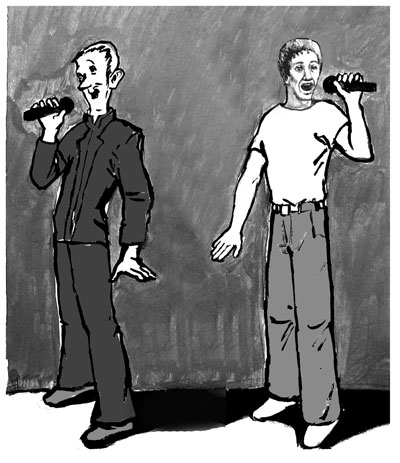Vocal Inadequacy
Vocal Inadequacy - In Need of Non-Surgical Voice Extension?
Written by Diana Yampolsky
 SIZE
MATTERS! Regardless of what anybody says, IT DOES. What am I talking
about you may ask? I am talking about the voice and the sound it
produces. As I have already mentioned before in previous columns, every
human being is born with vocal cords of a certain length and width, as
well as an individual facial structure. These two components play a
crucial role in determining the strength and quality of sound your voice
manufactures when singing.
SIZE
MATTERS! Regardless of what anybody says, IT DOES. What am I talking
about you may ask? I am talking about the voice and the sound it
produces. As I have already mentioned before in previous columns, every
human being is born with vocal cords of a certain length and width, as
well as an individual facial structure. These two components play a
crucial role in determining the strength and quality of sound your voice
manufactures when singing.
The SIZE of the vocal cords usually corresponds with the physical size of the person. (This is generally true but there can be exceptions.) With this in mind, it makes sense that a short petite woman would have short, thin vocal cords, which will assign to her a high soprano voice. While a natural soprano voice lends itself very well to classical singing, it does not suit styles such as R'n B, Rock or Dance, which require a much more solid bass foundation and much less vibrato. Soprano voices tend to naturally produce excessive vibrato, which again is very useful and pretty for classical singing, but can be a hindrance for other styles. Is there hope that soprano voices can sing styles other than classical? Yes, but it requires hard work from both the vocal student and an experienced voice educator.
Sound is determined by the quality of the instrument producing it. For example, let's compare two pianos. The first one is made of high quality wood and has steel strings. The hammers are also made from wood. The sound it produces is full and juicy and can even sometimes make an amateur player sound more accomplished The second piano is made out of 2X4 plywood. It's strings and hammers are made out of plastic. Not suprisingly, it sounds thin and dry and can have the reverse effect of making an accomplished player sound inadequate. The same applies to the anatomical and physiological structure that makes up your instrument and the size and quality of which will determine the level of your vocal performance.
Does this mean that if you were born with short, thin vocal cords that you are cursed with a thin and unpleasant sounding singing voice? The answer is not necessarily. To a certain degree, the vocal cords can be stretched in length and strengthened in terms of power. Just as a body builder is, through exercise, diet and stretching, able to increase the size of his muscles, so too can singers. I have developed a set of exercises that work to lengthen and strengthen the vocal cords, as well as develop deeper facial cavities, which are so important with regards to producing a strong-sounding voice. (Going "under the knife" is not required!)
The majority of students who come to our school for vocal instruction usually arrive with non-existent or incorrect vocal technique. In one of my previous articles, entitled Vocal Impotence - In Need of Vocal Viagra?, I defined how to correct these technical imperfections. But over the years, there have been many students for whom this was not enough. Yes, after "taking Vocal Viagra" the sound they produced was more "upstanding" and even "erected" but still short in length. Due to the natural shortness of their vocal cords, they did not have enough length to curve the sound into the facial cavities, which prevented the sound from resonating and achieving the secure aimed delivery. For these students, I needed to artificially lengthen the vocal cords and strengthen their lower abdominal and upper diaphragm muscles, as well as working on the facial cavities themselves in order to make them bigger and deeper. This is comparable to a gymnast who, over time, is able to increase his flexibility until he can comfortably perform the splits. He needs to be careful and well coached in order to avoid injury. Just as he gets to his desired place on almost an inch by inch basis, I have to bring my students along relatively slowly when developing a naturally undeveloped instrument. One exercise I use to develop facial cavities and strengthen the vocal cords is what I call the "Biting Exercise". It involves only the upper jaw and upper facial muscles and completely eliminates the lower jaw and vocal box itself, which releases and relaxes the vocal anatomy. The result is that the sound bounces off the upper palate in a curved position, which gradually increases the resonation and the body of the sound. This is one of many exercises that definitely work to achieve the desired result.
In a future article, I will talk about a couple unfortunate ailments that commonly infect singers: Vocal Constipation and Vocal Diarrhea. Look for the cures in the upcoming months.










